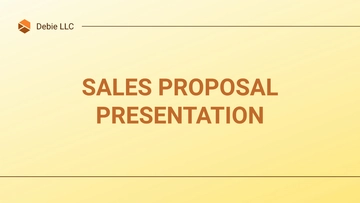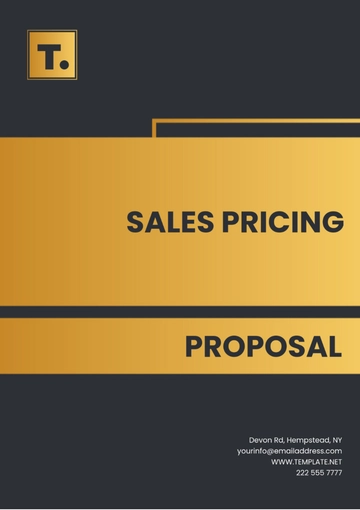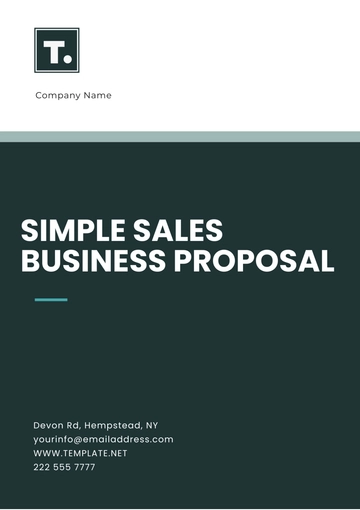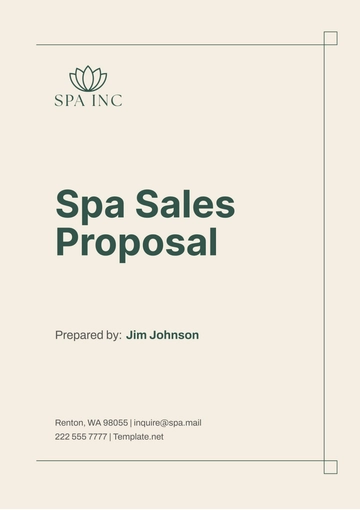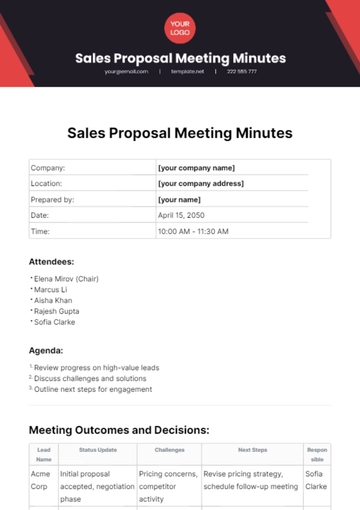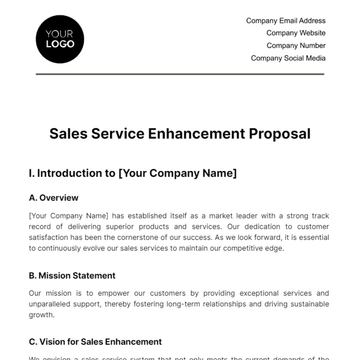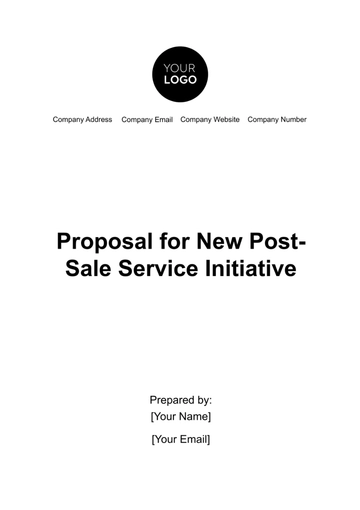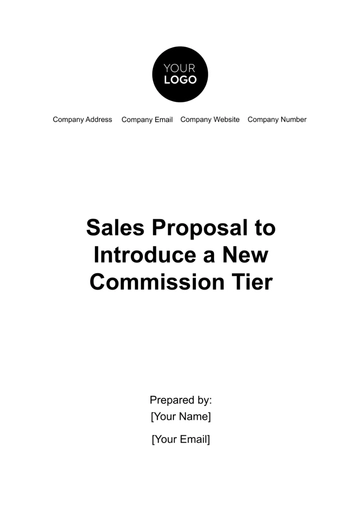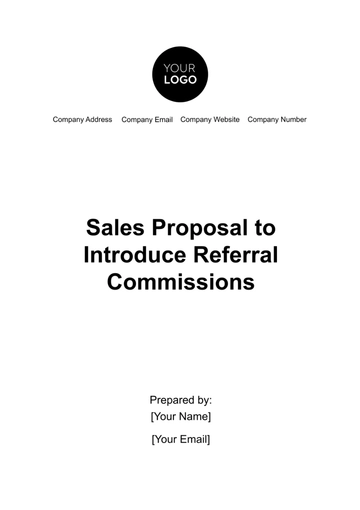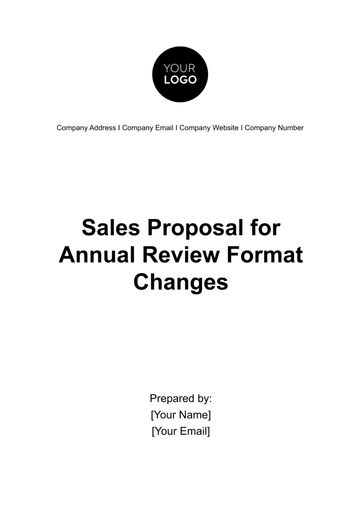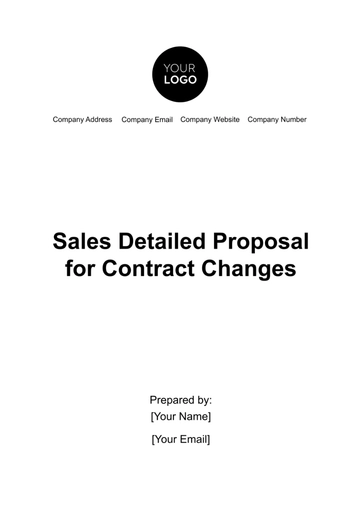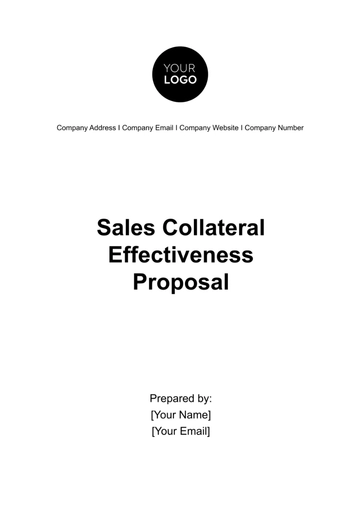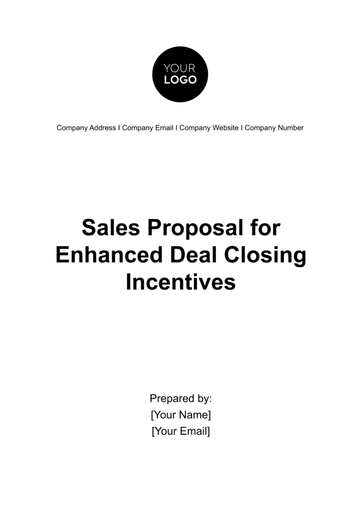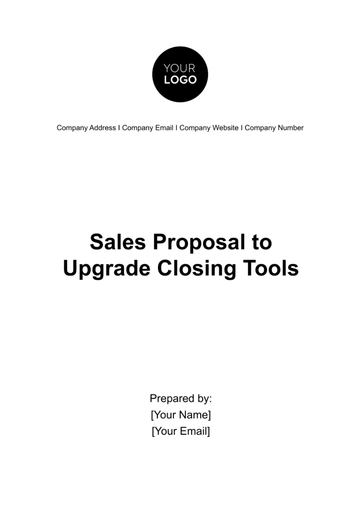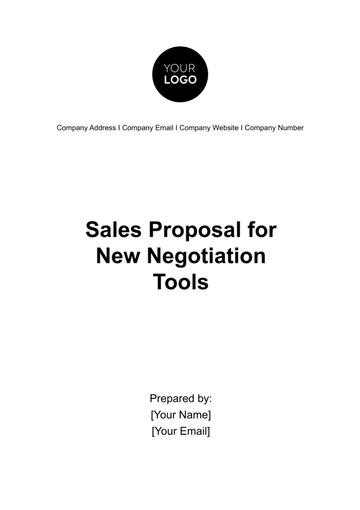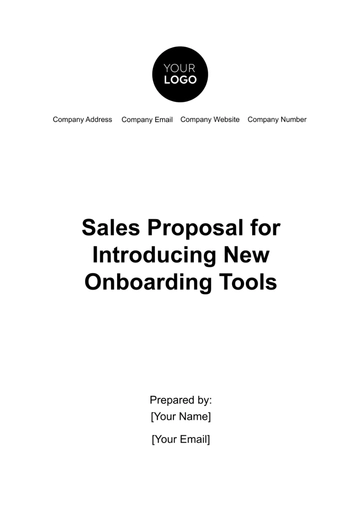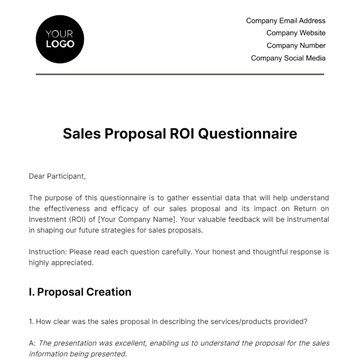Free Annual Sales Proposal

Prepared by: [Your Name]
Company: [Your Company Name]
TABLE OF CONTENTS
Executive Summary
1.1 Overview
1.2 Purpose of the Proposal
1.3 Proposal Highlights
Current Market Analysis
2.1 Market Overview
2.2 Market Trends
2.3 SWOT Analysis
Sales Objectives
3.1 Sales Goals
3.2 Target Market Segments
3.3 Growth Targets
Sales Strategies
4.1 Product/Service Offerings
4.2 Pricing Strategy
4.3 Marketing and Promotion
4.4 Sales Channels
4.5 Customer Relationship Management
Sales Team and Organization
5.1 Team Structure
5.2 Roles and Responsibilities
5.3 Training and Development
Sales Forecast
6.2 Annual Sales Projections
Sales Tactics
7.1 Prospecting and Lead Generation
7.2 Sales Presentations
7.3 Objection Handling
7.4 Closing Techniques
Sales Support and Resources
8.1 Sales Tools and Technology
8.2 Marketing Collateral
8.3 Customer Support
8.4 Sales Training Programs
Sales Metrics and Key Performance Indicators
9.1 KPIs for Sales Team
9.2 Sales Conversion Rates
9.3 Customer Satisfaction Metrics
Budget Allocation
10.1 Sales Budget
10.2 Marketing Budget
10.3 Resource Allocation
Sales Timeline
11.1 Annual Sales Calendar
11.2 Milestones and Deadlines
Risk Analysis
12.1 Risk Identification
12.2 Risk Mitigation Strategies
Conclusion
13.1 Summary of Proposal
13.2 Call to Action
1. Executive Summary
1.1 Overview
The Annual Sales Proposal for [Year] lays the foundation for an ambitious growth strategy by [Your Company Name] in the upcoming year. In this comprehensive document, we delve into the market landscape, sales objectives, strategic plans, and resource allocation that will drive our company's success.
1.2 Purpose of the Proposal
This proposal serves as a navigational guide, steering [Your Company Name] towards its growth aspirations. It unites our sales team's efforts under a common mission to not only meet but exceed the annual targets, fostering excellence in all aspects of our business.
1.3 Proposal Highlights
An in-depth market analysis, complete with key trends and competitive dynamics.
Clearly defined sales objectives and revenue projections.
An ingenious strategy to market our expanded product/service offerings.
A well-organized sales team, meticulously detailed with roles and responsibilities.
A comprehensive set of sales tactics, tools, and resources.
A sophisticated framework for monitoring and enhancing performance through sales metrics.
2. Current Market Analysis
2.1 Market Overview
The U.S. market continues its robust trajectory, reaching a size of $50 billion in [Year], with an impressive 80% YoY growth. This exemplifies a market ripe with opportunities for expansion.
2.2 Market Trends
Trends that warrant our attention include the surge in e-commerce, the sustainability wave, and the omnipresence of AI-driven customer engagement, which presents new avenues for innovation.
2.3 SWOT Analysis
Strengths | Extensive market presence, a diverse and adaptable product portfolio, a sterling brand reputation |
Weaknesses | |
Opportunities | |
Threats |
3. Sales Objectives
3.1 Sales Goals
For [Year], our sales goals are set ambitiously: a revenue target of ${amount) million, a market share growth of X%, and securing Y new high-value enterprise clients.
3.2 Target Market Segments
Our crosshairs are firmly set on three strategic segments: SMEs, the flourishing e-commerce sector, and the rapidly expanding healthcare industry.
3.3 Growth Targets
Our growth blueprint involves venturing into the European market, launching a groundbreaking healthcare product line, and solidifying our presence in the e-commerce domain.
4. Sales Strategies
4.1 Product/Service Offerings
We are thrilled to introduce an innovative AI-powered analytics tool, enriching our product range and propelling our competitive edge.
4.2 Pricing Strategy
Our pricing strategy balances competitiveness with premium options for discerning clients, designed to maximize profitability.
4.3 Marketing and Promotion
Our marketing strategy blends diverse channels including content marketing, social media campaigns, and email marketing to amplify our brand presence.
4.4 Sales Channels
Our multi-pronged approach includes direct sales, a revamped e-commerce platform, and strategic partnerships with industry leaders.
4.5 Customer Relationship Management
We will implement a proactive customer support system, employ real-time feedback mechanisms, and introduce customer loyalty programs to nurture enduring relationships.
5. Sales Team and Organization
5.1 Team Structure
Our sales team will be structured into three tiers: Sales Representatives, Sales Managers, and Support Staff, all reporting to the Sales Director.
5.2 Roles and Responsibilities
Roles and responsibilities will be finely delineated, with an emphasis on specialization and continuous skill development.
5.3 Training and Development
An investment in ongoing training and development will ensure our sales team remains at the forefront of industry knowledge and skill sets.
6. Sales Forecast
6.1 Quarterly Sales Projections
Our quarterly sales projections for [Year] are outlined below:
Q1 (January-March) | We anticipate a strong first quarter with revenue totaling $8.3 million, reflecting seasonal trends and new product launches. |
Q2 (April-June) | The second quarter is projected to yield $11.4 million, driven by summer promotions and increased demand. |
Q3 (July-September) | Although we expect a slight dip in sales, Q3 still shows strong performance, with revenues of $11.7 million |
Q4 (October-December) | The year culminates with a remarkable Q4, resulting in revenues of $13.8 million, driven by holiday sales and promotions |
6.2 Annual Sales Projections
Summarizing our annual sales projections for [Year], we aim to achieve a revenue target of $45 million, representing a remarkable growth rate of 20% compared to the previous year. This growth will be fueled by innovative product launches, an aggressive market presence, and enhanced customer relationships.
Our goal is to capture a market share growth of 15%, solidifying our position as a market leader. Our commitment to these ambitious targets is unwavering, supported by a combination of strategic marketing, effective sales tactics, and a well-trained sales team.
7. Sales Tactics
7.1 Prospecting and Lead Generation
Our prospecting and lead generation strategy for [Year] will leverage a multi-channel approach, blending inbound marketing, content marketing, and targeted outreach campaigns. We aim to generate a pipeline of 10,000 leads per quarter, with a focus on capturing high-value enterprise clients who align with our growth objectives.
7.2 Sales Presentations
To ensure effective sales presentations, we will implement a consultative approach, personalized for each prospect. Utilizing advanced CRM technology, our sales team will offer tailor-made solutions, showcasing how our products meet the specific needs and pain points of potential clients.
7.3 Objection Handling
Our strategy for objection handling involves active listening and empathetic responses. We expect to address and overcome common objections, such as pricing concerns, with persuasive solutions. Our aim is to maintain an objection resolution rate of 80%.
7.4 Closing Techniques
Closing techniques will encompass trial close, assumptive close, and alternative choice close strategies. We expect to achieve a successful deal closure rate of 65%, outperforming industry standards.
8. Sales Support and Resources
8.1 Sales Tools and Technology
Our sales team will utilize cutting-edge CRM software, predictive analytics tools, and automated sales pipelines to ensure efficiency and effectiveness. We anticipate a 20% improvement in lead conversion rates and a 15% increase in revenue per salesperson with these tools.
8.2 Marketing Collateral
Our marketing collateral includes interactive product brochures, compelling presentations, and comprehensive product documentation. These resources will assist the sales team in conveying product value, contributing to a 95% increase in successful sales presentations.
8.3 Customer Support
The synergy between customer support and sales will result in enhanced customer satisfaction. By addressing customer inquiries promptly and professionally, we aim to elevate customer satisfaction levels to 95%.
8.4 Sales Training Programs
To enhance the skills and knowledge of our sales team, we will conduct quarterly training programs. We anticipate a 10% increase in lead conversion rates and a 15% increase in revenue per salesperson after implementing these programs.
9. Sales Metrics and Key Performance Indicators
9.1 KPIs for Sales Team
Key performance indicators (KPIs) for our sales team will include measuring lead conversion rates, revenue per salesperson, and customer satisfaction levels. Our targets include a 20% increase in lead conversion rates, a 15% increase in revenue per salesperson, and an elevation of customer satisfaction levels to 95%.
9.2 Sales Conversion Rates
We will measure and improve sales conversion rates through enhanced sales training and objection handling strategies. Our goal is to achieve a 15% increase in sales conversion rates.
9.3 Customer Satisfaction Metrics
To further elevate customer satisfaction levels, we will focus on prompt issue resolution and a more personalized approach. Our target is a 10% increase in customer satisfaction levels, resulting in an overall satisfaction rate of 95%.
10. Budget Allocation
10.1 Sales Budget
Our sales budget for [Year] encompasses resource allocation for salaries, technology, marketing, and other expenses. We have allocated $12 million to support our sales efforts, ensuring we have the necessary resources to meet and exceed our targets.
10.2 Marketing Budget
The marketing budget for [Year] includes expenses for advertising, promotions, and campaign costs. We have allocated $8 million to promote our products and services effectively and expand our market presence.
10.3 Resource Allocation
Our resource allocation strategy is designed to support sales and marketing activities effectively. This includes optimizing our CRM technology and investing in additional sales training programs. These initiatives will facilitate our growth objectives and strengthen our market position.
11. Sales Timeline
11.1 Annual Sales Calendar
Our comprehensive annual sales calendar highlights key events, promotions, and product launches throughout the year. Key dates include seasonal promotions, product launches, and industry events to maintain a steady cadence of sales activities.
11.2 Milestones and Deadlines
Crucial milestones include lead generation targets, quarterly sales projections, and the achievement of specific KPIs. Associated deadlines have been set to ensure the team remains focused and motivated, driving us toward our annual objectives.
12. Risk Analysis
12.1 Risk Identification
Potential risks include economic downturns, shifts in market dynamics, and supply chain disruptions. We are prepared to mitigate these risks through proactive strategies and diligent monitoring.
12.2 Risk Mitigation Strategies
Our risk mitigation strategies involve diversification, agile market responses, and proactive supply chain management. By closely monitoring market dynamics and adapting swiftly, we can address potential
13. Conclusion
13.1 Summary of Proposal
In summation, the Annual Sales Proposal for [Year] epitomizes a robust strategy poised to achieve our lofty sales objectives and establish [Your Company Name] as an industry leader.
The amalgamation of innovative product offerings, a talented and motivated sales team, and an unwavering commitment to excellence will propel us toward a future of unprecedented growth.
13.2 Call to Action
We extend an invitation to our esteemed stakeholders to collaborate and partner with us to execute this strategy effectively. Together, we can redefine success and secure [Your Company Name] dominance in the marketplace.
- 100% Customizable, free editor
- Access 1 Million+ Templates, photo’s & graphics
- Download or share as a template
- Click and replace photos, graphics, text, backgrounds
- Resize, crop, AI write & more
- Access advanced editor
Template.net presents our customizable Annual Sales Proposal Template. This editable tool enhances marketing impactful presentations. Our template is editable in our Ai Editor Tool, allowing effortless design alterations. This user-friendly feature ensures a one-of-a-kind proposal, crucial to successful marketing. Experience the ease and efficiency of our tailor-made solutions that will set your ideas apart.
You may also like
- Business Proposal
- Research Proposal
- Proposal Request
- Project Proposal
- Grant Proposal
- Photography Proposal
- Job Proposal
- Budget Proposal
- Marketing Proposal
- Branding Proposal
- Advertising Proposal
- Sales Proposal
- Startup Proposal
- Event Proposal
- Creative Proposal
- Restaurant Proposal
- Blank Proposal
- One Page Proposal
- Proposal Report
- IT Proposal
- Non Profit Proposal
- Training Proposal
- Construction Proposal
- School Proposal
- Cleaning Proposal
- Contract Proposal
- HR Proposal
- Travel Agency Proposal
- Small Business Proposal
- Investment Proposal
- Bid Proposal
- Retail Business Proposal
- Sponsorship Proposal
- Academic Proposal
- Partnership Proposal
- Work Proposal
- Agency Proposal
- University Proposal
- Accounting Proposal
- Real Estate Proposal
- Hotel Proposal
- Product Proposal
- Advertising Agency Proposal
- Development Proposal
- Loan Proposal
- Website Proposal
- Nursing Home Proposal
- Financial Proposal
- Salon Proposal
- Freelancer Proposal
- Funding Proposal
- Work from Home Proposal
- Company Proposal
- Consulting Proposal
- Educational Proposal
- Construction Bid Proposal
- Interior Design Proposal
- New Product Proposal
- Sports Proposal
- Corporate Proposal
- Food Proposal
- Property Proposal
- Maintenance Proposal
- Purchase Proposal
- Rental Proposal
- Recruitment Proposal
- Social Media Proposal
- Travel Proposal
- Trip Proposal
- Software Proposal
- Conference Proposal
- Graphic Design Proposal
- Law Firm Proposal
- Medical Proposal
- Music Proposal
- Pricing Proposal
- SEO Proposal
- Strategy Proposal
- Technical Proposal
- Coaching Proposal
- Ecommerce Proposal
- Fundraising Proposal
- Landscaping Proposal
- Charity Proposal
- Contractor Proposal
- Exhibition Proposal
- Art Proposal
- Mobile Proposal
- Equipment Proposal
- Student Proposal
- Engineering Proposal
- Business Proposal

